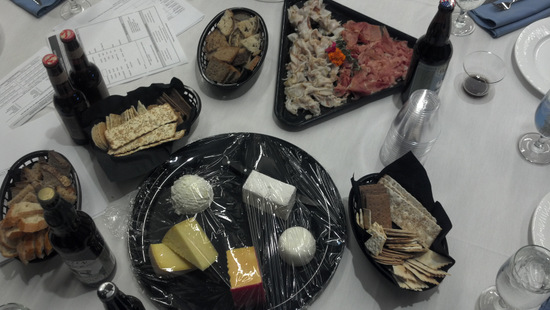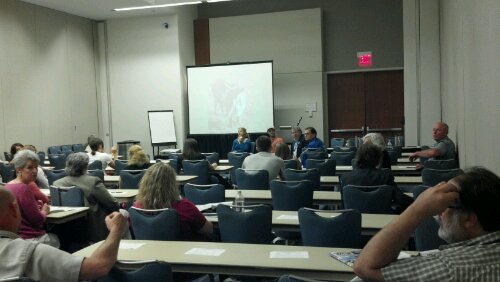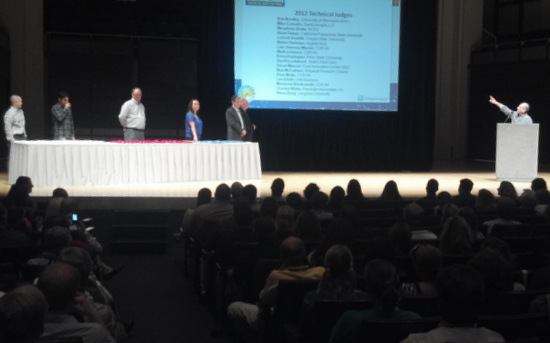
Dawn broke over the horizon this morning like a nicked yolk in a frying pan; although the humidity is visible, the temps, especially once the sun goes down, have been quite tolerable.

My first session sounds like a snoozer, but it dove into the white hot center of cheese regulation that is currently shifting like the beach during a hurricane. The panel for “Working Proactively to Mitigate Risks and Promote Cheese Safety” consisted of Dr. Cathrine Donnelly from VIAC, Cathe Strange from Whole Foods Market, Dr. Obianuju Nsofor from the FDA, and moderated by Bill Graves of the Dairy Research Institute. It began with a very discouraging presentation from Dr. Nsofor about the FDA’s take on their re-evaluation of dairy safety issues, specifically around the 60 day rule, which was adopted in the 1960s on the basis of assumptions (not scientific study) about pathogens viability in a high acid, low moisture environment. Better late than never, the FDA is now scientifically testing those assumptions, and they have not been bourn out, specifically with higher moisture cheeses aged over 60 days.
Without going too deep (though I may in a separate article or talk) the FDA remains very skeptical about maintaining the current rule about ALL raw milk cheeses required ONLY to be aged >60 days at a temp of >35degF. Moving forward they will continue their program of testing small and large cheese production facilities for environmental pathogens — they expect to test 264 facilities in FY2013 (beginning 10/1/12), and also continue to initiate and sponsor scientific study into this issue. With her last few words Dr. Nsofor related that the FDA is still in an early stage of the regulatory process, that once all available testing and science recommendations will be made to a panel who will review the recommendation and supporting work, etc. In other words an enforceable change is not immediately imminent, but change appears to be coming.
And then to cheer us up, Dr. Donnelly’s presentation was titled “How Risk Can Be Managed.” She began with a history of VIAC and why it was created, and why it hopes to expand its programs to a national level, and pointed out that in VIAC studies, she has found that most raw milk intended for raw milk cheese making is of high quality with low incidence of pathogens. That’s the good news. Then she told us that VIAC has also found that Good Manufacturing Practices are lacking in most farmstead facilities. Meanwhile VIAC continues to examine artisan and farmstead to better understand the best practices necessary to make high quality and safe raw milk cheeses. Her take away message was that cheese makers need to understand the risks they are required to mitigate.
Cathe Strange from Whole Foods spoke to the challenges faced at the retail level keeping the cheeses they receive at their peak, as well as auditing their suppliers and becoming a resource for them to navigate their own regulatory hurdles. She pointed out that “food safety in cheese making is the best it has ever been in history…at the same time the more we know, the more we know what we DON’T know.”

From there I moved to a session guaranteed to increase my cheer was to explore the fermented foods of North Carolina. On the face of it this was a tasting of local beer and cheese, but it was actually a tasting of five different beers, 5 different cheeses, four different breads, and two local cured meats. Author (Atlas of American Artisan Cheese) curated the tasting along with experts on the local beer and food, and they chose a flight of one beer with one cheese, but then allowed the audience to freestyle, tasting cheese and breads, beer and ham, beer and lardo, meats and breads and beer, etc. It was all good, and illuminating about the pairing potentials that I could offer to my customers who sometimes ask me, “what should I do with your cheese?”

After lunch I was interested to learn about the “Animal Welfare Approved” (AWA) program, but unfortunately the presenter (Program Director Andrew Gunther) seemed mostly unprepared to inform the audience about the program. Instead most of the session was devoted to interviewing two cheese makers who are AWA certified about how they got started farming, why they farm, and the challenges that they faced getting up to speed. It was only at the very end of the session, under the gun of a time countdown, that the issue of how and why to get certified was even broached. Unfortunately not every session can be a thrilling exploration of a subject (or several beer and cheese combos), but it does happen.
Next up: AWARDS. I wil be tweeting the results from the auditorium, so if you want Real Time notification, follow the Guild’s twitter handle @MECheeseGuild. Unfortunately, because the awards come fast and furious, that’s all I have time to do in the moment, and then afterwards there are events and dinner, etc. So any Maine awards may not be posted here possibly not until Saturday.

Waiting in anticipation of the announcements.
